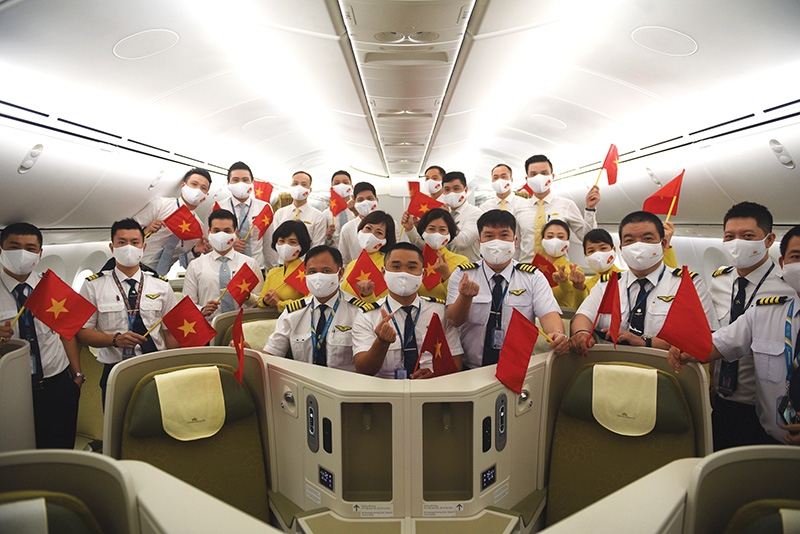Nation wary of COVID-19 nuisance from overseas
 |
| Vietnam Airlines landed in San Francisco with a new Boeing 787-10 to pick up citizens, Photo: Vietnam Airlines |
In the afternoon of May 7, many Vietnamese were shocked by information from the Ministry of Health about 17 new positive coronavirus cases. All of these cases were Vietnamese people returning from the Middle East with the support of Vietnamese government agencies, the Vietnamese Embassy in the UAE, and national carrier Vietnam Airlines.
Immediately after their entry, all 297 passengers were taken to the quarantine area at Bac Lieu province for testing samples. There were 17 positive cases with SARS-CoV-2 and 280 who tested negative.
This incident has raised concerns about the risk of further outbreaks in the near future, especially as Vietnam begins to increase the frequency of domestic commercial flights and prepares to resume international flight routes in early June.
One concerned citizen, Minh Phuong, shared with VIR, “Although the government has done a good job in preventing and controlling the pandemic, and travellers from abroad have been isolated, I still feel very nervous. I hope no more cases from outside will enter the community because the past few months have been exhausting enough.”
These concerns are seen to be understandable because recently, the government has restarted flights to bring Vietnamese citizens from abroad after more than a month of suspension to control the disease in the country.
At the end of April, a Vietjet flight landed safely at Can Tho International Airport, bringing more than 200 Vietnamese citizens from Singapore. Shortly thereafter, the Vietnam Embassy in Canada and Vietnam Airlines co-operated with Canadian authorities to bring back nearly 300 citizens. On May 6, a flight carrying 224 Vietnamese from France also landed at Van Don International Airport.
Recently, the Ministry of Foreign Affairs announced that it has completed all necessary procedures to organise the return of Vietnamese citizens, such as the flight from San Francisco which landed successful at Van Don International Airport on May 8, bringing home 340 Vietnamese citizens. Those who travel on these flights after landing will be put under medical examination and isolated for 14 days.
Not only is there a potential threat via the air, Vietnam is also wary of other threats coming from border gates from neighbours such as China, Laos, and Cambodia. Recently, some border gates in central Vietnam have opened to welcome Vietnamese citizens. Nam Dan district’s concentrated isolation area in the central province of Nghe An announced that it has received and quarantined 182 citizens from Laos and Thailand, bringing the total number of quarantined citizens in Nghe An from the beginning of May to 397.
Previously, Nghe An also received 215 citizens from Laos and Thailand to return to Vietnam via the Cau Treo international border gate in the central province of Ha Tinh, and the Nam Can border gate in Nghe An. These citizens had body temperature measured, made to complete information declarations, and were sent to a centralised isolation facility for at least 14 days.
Vietnam is currently considered by the international community to be a successful model in the prevention of the ongoing pandemic with fewer than 300 people infected and no deaths thus far.
Over the past 20 days, no new cases of infection have been detected in the community, and the locked-down Ha Loi hamlet in Hanoi’s Me Linh district was officially reopened, allowing more than 10,000 local residents to return to normalcy after 28 days in isolation to prevent the transmission of COVID-19.
The Vietnamese government reaffirmed that it would not neglect potential risks from outside, although the number of flights and border gates open to welcome Vietnamese citizens abroad to return home may increase in the upcoming time.
| Herbert - Laubichler-Pichler, general manager Alma Resort Cam Ranh
We are very happy and impressed with the Vietnamese authorities’ initial management and handling of this crisis. Vietnam’s response has been hailed worldwide as a huge success, based on quick and thorough action that kept the number of cases very low. With social distancing measures easing, all hotels, resorts, and restaurants need to ensure they are implementing sweeping safety and hygiene measures to protect people from the threat of COVID-19. Perhaps the government could issue strict safety, hygiene, and social distancing rules for every hotel, resort, and restaurant, and make sure everything is followed up with random checks by inspectors and auditors. We are all in the same boat and if someone is not taking the threat seriously, it jeopardises not only the entire tourism industry’s efforts but also, significantly, the broader community’s health and people’s lives. We do not want to undo all of the fantastic work that has been achieved in Vietnam so far. The idea of an outbreak occurring now is frightening. Unfortunately, the reality is we are still only at the beginning of this and until there is a vaccine or cure, we cannot go back to how we used to behave. It is too early now to relax; we all need to do everything we can to protect each other. Adam Bury - Executive vice president, JLL’s Hotel & Hospitality Group
We see that Vietnam has moved quickly in order to help mitigate the impact of the pandemic on the tourism industry. In particular we have seen new government circulars issued which have encouraged the State Bank of Vietnam to work with commercial lenders to provide restructuring solutions and reducing fees where borrowers and enterprises may be significantly impact by the impacts of COVID-19, whilst the Ministry of Finance is providing assistance on potential tax payment extensions to help cash flows of those impacted. This is typically in line with approaches from across the region and is similar to measures in Thailand, where Bank of Thailand has reduced the interest rate, local authorities have deferred tax payments until the end of August, and private banks are providing loan holidays up to six months. Moving forward, it is key that government’s and related agencies focus on recovery of the tourism industry. For example, the Singapore Tourism Board has launched an S$20m ($14.16 million) Marketing Partnership Programme to help tourism-related business. With Vietnam having so far been successful in containing the virus and now re-opening the economy and tourism industry, it is critical that the country is strategically marketed in order to help further recover from the downturn. |
What the stars mean:
★ Poor ★ ★ Promising ★★★ Good ★★★★ Very good ★★★★★ Exceptional
 Tag:
Tag:
Themes: Together We Win
- Greater Mekong Subregion executives to discuss sustainable tourism
- TCPVN donates 1,200 medicine bags to COVID-19 patients in southwest
- AB InBev supports orphans with scholarships amid COVID-19
- Evaluating the reach of support in turbulent times
- Gamuda Land grants “Back to School” scholarships to support disadvantaged students
Related Contents
Latest News
More News
- Protect what’s next: towards a future free from meningococcal group B disease (December 05, 2025 | 18:00)
- New ILO report offers policy recommendations for disability inclusion (December 04, 2025 | 15:18)
- Maternal job loss may affect children’s mental health, research shows (December 03, 2025 | 19:11)
- Women lead Vietnam’s shift to climate-resilient agriculture (December 03, 2025 | 19:10)
- Experts highlight unpaid care work as key barrier to gender equality (December 03, 2025 | 15:15)
- Opportunities and inequalities for women workers in Vietnam's garment industry (December 03, 2025 | 09:00)
- Vietjet flights carry love to devastated central region (November 28, 2025 | 11:35)
- New initiative to boost the fight against domestic violence (November 26, 2025 | 10:00)
- South Korea funds IOM relief for Vietnam’s typhoon-affected communities (November 24, 2025 | 15:33)
- AI and human-centred values set to shape the future of HR in Vietnam (November 21, 2025 | 18:04)


























 Mobile Version
Mobile Version